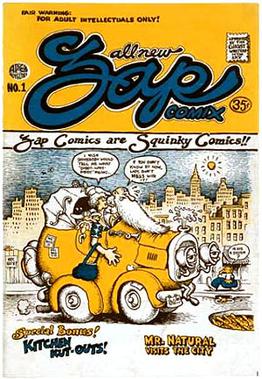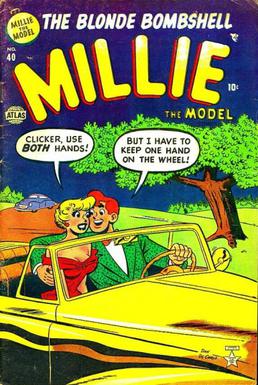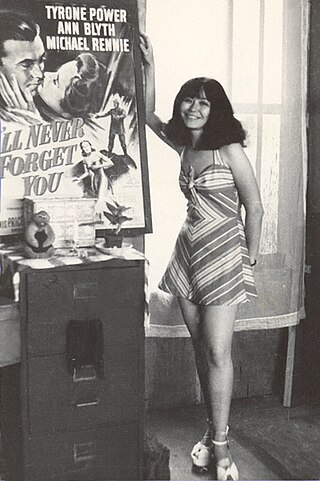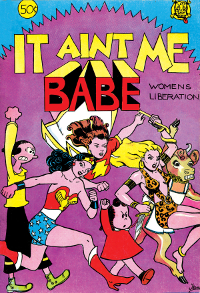
Underground comix are small press or self-published comic books that are often socially relevant or satirical in nature. They differ from mainstream comics in depicting content forbidden to mainstream publications by the Comics Code Authority, including explicit drug use, sexuality, and violence. They were most popular in the United States in the late 1960s and 1970s, and in the United Kingdom in the 1970s.
Tarpé Mills was the pseudonym of the American comic book creator June Tarpé Mills, one of the first major female comics artists. She is best known for her action comic strip Miss Fury, featuring the first female action hero created by a woman.

Star Comics was an imprint of Marvel Comics that began in 1984 and featured titles that were aimed at child readers and were often adaptations of children's television series, animated series or toys. The last comic published under the imprint featured a May 1988 cover date, although the Star Comics Magazine continued through December 1988. Some of the titles continued after that, being published directly by Marvel. Several of the original titles consciously emulated the house writing and visual style of then-recently defunct Harvey Comics titles such as Richie Rich.
Roberta Gregory is an American comic book writer and artist best known for the character Bitchy Bitch from her Fantagraphics Books series Naughty Bits. She is a prolific contributor to many feminist and underground anthologies, such as Wimmen's Comix and Gay Comix.

Wimmen's Comix, later retitled (respelled) as Wimmin's Comix, is an influential all-female underground comics anthology published from 1972 to 1992. Though it covered a wide range of genres and subject matters, Wimmen's Comix focused more than other anthologies of the time on feminist concerns, homosexuality, sex and politics in general, and autobiographical comics. Wimmen's Comix was a launching pad for many cartoonists' careers, and it inspired other small-press and self-published titles like Twisted Sisters, Dyke Shorts, and Dynamite Damsels.

Millie the Model was Marvel Comics' longest-running humor title, first published by the company's 1940s predecessor, Timely Comics, and continuing through its 1950s forerunner, Atlas Comics, to 1970s Marvel. The comic book series deals with Millie Collins, an aspiring model working for the Hanover Modeling Agency.

Trina Robbins is an American cartoonist. She was an early participant in the underground comix movement, and one of the first female artists in that movement. She is a member of the Will Eisner Hall of Fame.

The Blonde Phantom is a fictional masked crime fighter appearing in American comic books published by Marvel Comics. Created for Marvel predecessor Timely Comics by Stan Lee and Syd Shores, the character first appeared in All Select Comics #11, during the 1940s period fans and historians call the Golden Age of Comic Books. The heroine was so well received that the next issue was retitled The Blonde Phantom. The series continued to feature her until issue #22. She also appeared in backup stories in many other Timely comics; in Superhero Comics of the Golden Age, Mike Benton observes that "for a few months in 1948, readers could find her in seven titles on the newsstand." In The Supergirls, Mike Madrid asserted, "Once again, a capable woman hid behind a meek persona and only let her hair down, literally, to come to the aid of a man who completely ignored her unless she assumed a disguise. In a 1947 story entitled "I Hate Myself", Louise even dreams that Mark finally confesses his love for her, only to have the Blonde Phantom persona appear and steal him away."
Ruth Atkinson Ford, née Ruth Atkinson and a.k.a. R. Atkinson, was an American cartoonist and pioneering female comic book writer-artist who created the long-running Marvel Comics character Millie the Model and co-created Patsy Walker.

Florence Steinberg was an American publisher of one of the first independent comic books, the underground/alternative comics hybrid Big Apple Comix, in 1975. Additionally, as the secretary for Marvel Comics editor Stan Lee and the fledgling company's receptionist and fan liaison during the 1960s Silver Age of Comic Books, she was a key participant of and witness to Marvel's expansion from a two-person staff to a pop culture conglomerate.

Dakota North is a fictional comic book character who has appeared in various series published by Marvel Comics. Created by writer Martha Thomases and artist Tony Salmons, North was originally the star of her own short-lived 1986 series and later a part of the supporting casts of Cage, Daredevil and Captain Marvel. The character exists in Marvel's main shared universe, known as the Marvel Universe.

Lee Marrs is an American cartoonist and animator, and one of the first female underground comix creators. She is best known for her comic book series The Further Fattening Adventures of Pudge, Girl Blimp, which lasted from 1973 to 1977.
The portrayal of women inAmerican comic books has often been the subject of controversy since the medium's beginning. Critics have noted the roles of women as both supporting characters and lead characters are substantially more subjected to gender stereotypes, with femininity and/or sexual characteristics having a larger presence in their overall character.
Mary Wings is an active American cartoonist, writer, and artist. She is known for highlighting lesbian themes in her work. In 1973, she made history by releasing Come Out Comix, the first lesbian comic book. She is also known for her series of detective novels featuring lesbian heroine Emma Victor. Divine Victim, Wings' only Gothic novel, won the Lambda Literary Award for Lesbian Mystery in 1994.
Although, traditionally, female comics creators have long been a minority in the industry, they have made a notable impact since the very beginning, and more and more female artists are getting recognition along with the maturing of the medium. Women creators have worked in every genre, from superheroes to romance, westerns to war, crime to horror.

It Ain't Me Babe Comix is a one-shot underground comic book published in 1970. It is the first comic book produced entirely by women. It was co-produced by Trina Robbins and Barbara "Willy" Mendes, and published by Last Gasp. Robbins and other staff members from a feminist newspaper in Berkeley, California, also called It Ain't Me, Babe, contributed. Many of the creators from the It Ain't Me Babe comic went on to contribute to the long-running series Wimmen's Comix.
Mary Wilshire is an American comics artist best known for her work on Red Sonja and Firestar for Marvel Comics.
Angela Bocage is a bisexual comics creator who published mainly in the 1980s and 1990s. Bocage was active in the queer comics community during these decades, publishing in collections like Gay Comix,Strip AIDS USA, and Wimmen's Comix. Bocage also created, edited, and contributed comics to Real Girl, a comics anthology published by Fantagraphics.

California Girls is a creator-owned American comedy-romance comic series created by Trina Robbins. Published by Eclipse Comics between 1987 and 1988, the series chronicled the adventures of identical twin high school students Max and Mo in the fictional Californian town of Hollyhock. It was one of the few comics aimed at a primarily female audience published at the time.











